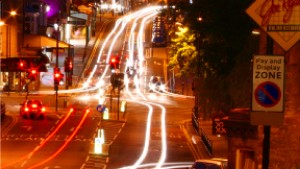|

OK, driving in the dark is not as safe nor romantic as dancing in the dark. We’re all aware that being on the road after sundown is a serious and difficult task for senior drivers.
Suggestions: During the day we can see in all directions for accuracy, reactions and visibility. When driving at night, senior drivers should:
1. Be in good health: Older people who wear glasses and drive regularly at night, should schedule regular appointments with family doctors or eye specialists to correct anything that could obstruct normal vision. If necessary, prescribed special driving glasses can improve safety on the road.
2. With regular garage check-ups, be sure the car is in good night driving shape. Include the electrical system, lights, electronics, heating and air conditioning, tires, engine and other vital parts.
3. On the night roads, obey speed laws, traffic lights, construction warnings and all other potential troubles. Even if traffic is light, the urge for excess speed at night, especially on an unfamiliar road, may be too dangerous for senior eyes and reflexes.
4. Maintaining personal safety for senior drivers is important when night traveling. Drive and stop only in well-lighted areas, and always keep your doors locked, whenever you’re inside or out of your car.
5. If there are passengers aboard, they must help the driver by reducing distracting bright lights on the dashboard, overhead and elsewhere inside the car. Conversations, loud music and other sounds should not involve the senior driver, who should always concentrate on the road ahead.
6. Use GPS to find locations, get info about possible road interruptions ahead. Use it also to contact local police and book for hotels, restaurants, gas stations and other facilities.
7. Use your SmartPhone briefly and only when necessary. If required to talk or visually scan for more than a few seconds, pull over and stop safely. Obey new and existing laws about texting while driving, or anything else that takes driver attention away from the road.
8. Use the car’s headlight brights only when no oncoming traffic is approaching within 100 feet, then cut to your dimmers. In unfamiliar areas and where the road has many turns, use brights only when absolutely necessary and won’t glare dangerously at other drivers.
9. It’s a well-known fact that drinking and driving can lead to accidents, as well as serious legal troubles. If at an event after dark, and you have had any alcoholic drinks, ask a non-drinking friend to take you home or call a taxi.
10. Show courtesy for other drivers. When your senior vision and reaction times are limited, the way ahead can be dangerous. By obeying the laws and being respectful of the rights of others on the road, you enhance safety for all.
|

